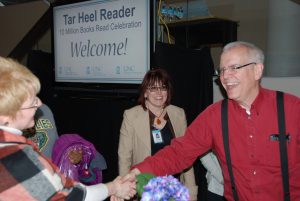
Computer scientist Gary Bishop (right) welcomes a visitor at a celebration marking 10 million books read for Tar Heel Reader, an online program that helps students with disabilities learn to read independently. (photo courtesy of UNC computer science)
Tar Heel Reader, an online program that helps students with disabilities learn to read independently, reached 10 million books read in January. The site, created by Karen Erickson of the Center for Literacy and Disability Studies and Gary Bishop of the department of computer science, reached the milestone less than a decade after its launch.
Tar Heel Reader is an online collection of free, easy-to-read and accessible books on a wide range of topics. The site was built to fight illiteracy among underserved populations, including those with disabilities that make it difficult to learn to read using traditional books and learning methods. Each book in the collection can be speech-enabled and accessed using multiple types of interfaces.
In 2008, Bishop worked with Erickson to build Tar Heel Reader as a way for users to create beginner-level books aimed at older children and adolescents with disabilities.
Although it was originally built for readers with disabilities in the United States, the site’s ease of use has made it a popular choice for a variety of language teachers and students across the world. The library now contains more than 50,000 books in 27 languages and has been accessed by users in more than 200 countries and territories.
“I’m a programmer, so I’m an optimist,” Bishop said, “but I’m amazed by how far-reaching Tar Heel Reader has become. If you search ‘Tar Heel Reader’ on YouTube, you can find videos explaining in German how to set it up with a switch. There are even demonstrations that use puppets and stop motion video to explain the process.”
